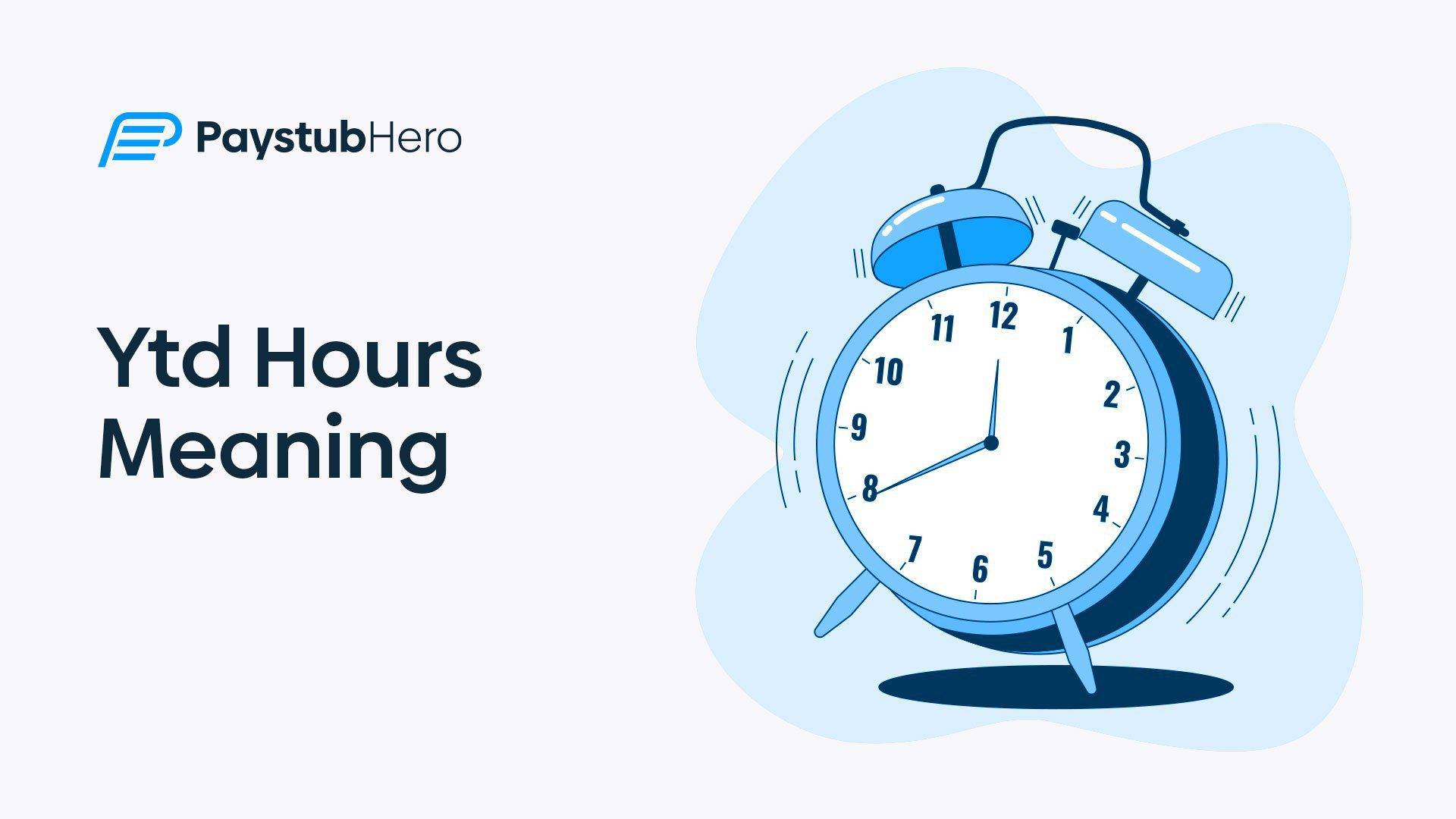YTD hours meaning: YTD stands for “Year-to-Date. Deciphering the coded language of payroll jargon can sometimes feel like trying to solve a complex puzzle. To entrepreneurs, freelancers, and small business owners who wear many hats and juggle multiple responsibilities, these phrases can seem like an added hurdle in their quest to understand their financial health.
One such term that often stirs confusion is “YTD hours.” But what does it mean? In the most straightforward sense, “YTD hours” refers to the total number of hours worked from the start of the current calendar or fiscal year until now.
We know it might feel overwhelming at first, and that’s why we’re here to simplify things for you. We want you to feel confident and informed when it comes to understanding your payroll and financial data. Our goal with this article is to break down these complex terms into digestible nuggets of information.
In addition to “YTD hours,” there are several other phrases under the “YTD” umbrella that are equally important to comprehend.
From “YTD return” and “YTD gross” to “YTD net pay” and “YTD earnings,” we will walk you through the meaning of these terms and why they matter to your financial and business health.
Armed with this knowledge, you will be better equipped to assess your financial progress and make informed decisions.
So, let’s roll up our sleeves, dive into the world of YTD terminology, and demystify these terms one by one.
Table of Contents:
- Introduction
- Unraveling the Meaning: What Does “YTD” Stand For?
- YTD Return: An Insightful Indicator of Your Investment Performance
- YTD Gross and Net Pay: Demystifying Your Income
- YTD Earnings: A Comprehensive View of Your Financial Health and Progress
- YTD Hours: Your Time Investment Captured and Valued
- Maximizing YTD Metrics with Paystubhero: Simplifying Payroll Management for Entrepreneurs, Freelancers, and Small Businesses
- Conclusion and Call to Action
Unraveling the Meaning: What Does “YTD” Stand For?
Before we venture further into the realm of YTD terminology, it’s vital to first clarify what exactly “YTD” stands for. The abbreviation “YTD” represents “Year To Date.” It’s a common phrase that you’ll often come across in various fields, including finance, accounting, and human resources.
The term is frequently used to indicate a period commencing from the beginning of the current year, whether that’s the calendar or fiscal year, and ending at the present date.
Now, you might wonder why such a term is relevant or how it is employed in day-to-day business operations. The significance of “YTD” lies in its ability to provide a snapshot of your performance or financial standing in a given year.
Whether you’re assessing the performance of your investments, evaluating your earnings, or tracking the number of hours worked, “YTD” becomes a vital tool in your financial arsenal.
In essence, “YTD” serves as a marker, enabling you to gauge your progress from the start of the year until the current moment. It offers a holistic perspective of how your business or financial standing has evolved and changed over time, helping you make informed decisions and strategic plans for the future.
Now that we’ve laid a strong foundation of understanding what “YTD” stands for, let’s explore how it applies to different aspects of your financial journey.
YTD Return: An Insightful Indicator of Your Investment Performance
YTD isn’t just limited to payroll terms; it has a significant role in the world of finance and investments as well. “YTD return” is a term often used in the realm of finance and investments, and understanding it can provide key insights into your financial journey.
In the simplest terms, “YTD return” refers to the profit or loss made by an investment since the start of the calendar or fiscal year. It’s a crucial metric that can offer a comprehensive understanding of how well your investments are performing in a given period.
To illustrate this, let’s say you’ve invested in the stock market. As you probably know, the performance of your investments can fluctuate due to a variety of factors, including market trends, economic conditions, and company performance.
Monitoring these fluctuations on a daily basis could be overwhelming, if not chaotic. This is where the concept of YTD return comes into play.
Instead of getting lost in the daily ebbs and flows, the YTD return offers a consolidated view of your investment performance from the beginning of the year until now.
For example, if your YTD return shows a 15% increase, it means that your investments have grown by that percentage since the first day of the year.
Not only does this give you a clearer picture of your investment’s overall growth or decline, but it also allows you to compare the performance of different investments. By doing so, you can identify which investments are performing well and which ones might need reevaluation.
In essence, understanding your YTD return can be a crucial component of effective financial planning and investment strategy.
YTD Gross and Net Pay: Demystifying Your Income
Understanding the difference between “YTD gross” and “YTD net pay” is fundamental for managing your income effectively. These two terms, although closely related, provide different perspectives on your earnings and take into account various factors impacting your take-home pay.
Let’s start with “YTD gross.” This refers to your total earnings before any deductions are made. These earnings include not just your salary, but also any bonuses, overtime, or other forms of compensation you may have received from the beginning of the calendar or fiscal year until now.
Essentially, it represents the full amount of money you’ve earned before any slices of the pie are taken out.
On the other side of the coin is your “YTD net pay.” This term refers to the amount left after all necessary deductions are taken out from your YTD gross.
These deductions can range from taxes, social security, healthcare costs, employee contributions, and more. This figure is essentially what you take home – it’s the money you have in your pocket to spend, save or invest.
So why is it important to understand these two terms? Well, having a clear comprehension of your YTD gross and net pay can be beneficial in many ways.
For one, it allows you to understand how much of your earnings are going towards deductions, giving you a more accurate idea of your actual take-home pay. It also assists in planning your finances, managing your tax obligations, and budgeting effectively.
Whether you’re a freelancer balancing multiple gigs or a small business owner managing your payroll, understanding your YTD gross and net pay can provide valuable insights into your financial health, allowing you to make informed decisions and plan your financial future more effectively.
YTD Earnings: A Comprehensive View of Your Financial Health and Progress
While understanding YTD hours, gross, and net pay are crucial, another term that plays an essential role in assessing your financial status is “YTD earnings.” This term offers a more holistic view of your income, encompassing not just your basic salary, but all forms of income you have received during the year.
In essence, “YTD earnings” refers to the aggregate of all income earned over the year up until the current date. This includes your base salary, but also expands to other sources of income such as bonuses, commissions, tips, or any other forms of compensation that you might have received.
This metric gives you a comprehensive understanding of your overall income, painting a detailed picture of your financial progress throughout the year.
Why is this important, you might ask? The significance of understanding your YTD earnings lies in its ability to provide a complete picture of your financial health. This information is not only crucial for personal financial planning and budgeting, but also plays a vital role when you’re applying for loans or mortgages, as lenders often look at this figure to assess your creditworthiness.
Furthermore, for freelancers and small business owners, having a handle on your YTD earnings can be beneficial when making business decisions, evaluating your pricing strategy, or assessing the sustainability of your income streams.
In short, understanding your YTD earnings can be an effective tool for both personal and business financial management.
YTD Hours: Your Time Investment Captured and Valued
Let’s circle back to our original query, “YTD hours.” You’re now familiar with the concept of YTD, but how does it apply to hours? Simply put, “YTD hours” signifies the total time you’ve spent working from the beginning of the year until now.
This metric is especially vital for those who bill their clients by the hour, like freelancers and independent contractors, as it directly impacts their income and earnings.
Think of “YTD hours” as a mirror reflecting your time investment in your work. This figure does more than just represent the hours you’ve clocked in; it provides valuable insights into your work habits, productivity, and potentially, your work-life balance.
Let’s illustrate this with an example. Assume you’re a graphic designer who has been juggling various projects since the beginning of the year. You meticulously track your time spent on each project. Now, it’s June, and you want to know your total hours worked for the year.
By adding all those tracked hours from January until now, you get your “YTD hours.” This not only helps you understand your work pattern but can also help in future project planning and time management.
Additionally, understanding your YTD hours can have significant implications for your financial planning. For instance, by knowing how many hours you’ve worked and comparing that with your YTD earnings, you can effectively calculate your average earnings per hour. This can be an invaluable metric when negotiating contracts, setting your rates, or assessing the profitability of your work.
In essence, comprehending your YTD hours gives you a snapshot of your time investment, enabling you to gauge your productivity and make informed decisions about your work and financial strategies.
Maximizing YTD Metrics with Paystubhero: Simplifying Payroll Management for Entrepreneurs, Freelancers, and Small Businesses
Understanding YTD terms and their implications is only half the battle; the other half is effectively managing these metrics to ensure your financial well-being. This is where Paystubhero comes in.
As an online payroll software designed specifically for entrepreneurs, freelancers, small businesses, and independent contractors, Paystubhero offers a streamlined, efficient, and affordable solution for payroll management.
Paystubhero goes beyond traditional payroll services. Instead of merely generating pay stubs, it helps you navigate the complex world of payroll, equipping you with the tools to manage your YTD hours, gross pay, net pay, earnings, and more.
By using Paystubhero, you can gain insights into these important YTD metrics, ensuring that you’re always informed about your financial health and progress.
With Paystubhero, payroll management becomes a hassle-free process. All you need to do is enter your company and employee information, and the software will handle the calculations.
No more headaches over complex payroll computations or stress about errors. With Paystubhero, you have a reliable, efficient, and easy-to-use tool at your fingertips.
Additionally, Paystubhero’s affordability and robust features make it an ideal choice for those who may not have access to larger payroll software like ADP or Gusto. If you’re a solopreneur striving to keep track of multiple income streams, a freelancer looking to understand your earnings better, or a small business owner managing your team’s payroll, Paystubhero is designed with you in mind.
By providing a clearer understanding of your YTD metrics and simplifying payroll management, Paystubhero empowers you to make better financial decisions, plan for the future, and focus on what truly matters: growing your business and achieving your goals.
In conclusion, understanding the meaning and implications of YTD metrics such as YTD hours, gross pay, net pay, and earnings, is essential for anyone striving to manage their finances effectively.
And with tools like Paystubhero, mastering these metrics becomes not just possible, but straightforward and efficient.
Interested in experiencing a more effortless way of managing your payroll? Start your journey with Paystubhero today. It’s as easy as 1-2-3!
Frequent Asked Questions
- What does the YTD amount mean?
- The YTD (Year-to-Date) amount represents the total of a particular figure (such as income, expenses, hours worked, etc.) from the beginning of the current year up to the present day.
- What is the YTD hour unit?
- The YTD hour unit refers to the total hours you have worked from the start of the year up until now. It’s a cumulative measure of your time investment in your work.
- What is the pay period for YTD?
- The pay period for YTD spans from the beginning of the current calendar or fiscal year to the present day. It includes all the pay periods that have occurred within this timeframe.
- What does YTD mean on the ADP app?
- On the ADP app, YTD refers to the year-to-date totals for various payroll figures such as hours worked, gross pay, deductions, and net pay. It provides a snapshot of your earnings and payroll data from the beginning of the year to the present.








